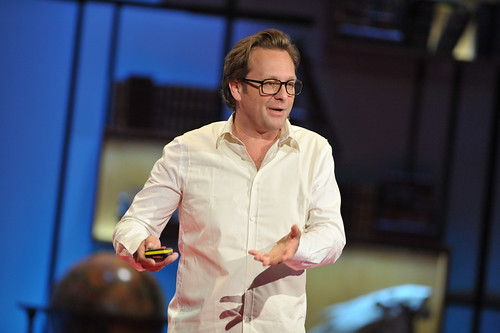Daniel Birnbaum is a curator and is especially known for curating the Venice Biennale. He begins by answering the question, “What does a curator do?” He says that a curator is someone who shows things, puts things on display. “What a strange career!” he exclaims. He explains that if the curator is very successful, the he or she should not be so visible.
There was a time, Birnbaum says, when it was easy to say what art is. He shows slides of a show in Vienna of the history of frames. We used to be able to say that art was the thing inside the frames, he points out, but the frames themselves have become art. Now, he says, modern art has seen a disappearance of the frame. The framing seems to have become bigger and is now the gallery the salon, the museum. In a show like the Venice Biennale or any other big show it’s not longer clear what the art is and maybe the framing device is the city itself.
He has a brief clip to show that curating isn’t an exact science. One of the artists participating in the Venice Biennale, Mike Bouchet, brings a typical American house to Venice and floats the suburban home on the water of the canals. It’s a bizarre and fascinating image, and in the end, the house sinks. Birnbaum describes the American house sinking into a Venetian canal as a disaster in logistics but a memorable performance in art.
He says that the world of contemporary art used to be small and bohemian, and now it has become very large and global. The world of art is now also governed by fashion, lifestyle and huge amounts of money. He shows a clip of a piece by Mark Rothko being auctioned, and the bidding is continuing well over $35 million. Birnbaum stops the clip and tells us that eventually it went for $45 million. This might make us think that art world is drenched in money. But as someone who teaches art, he assures us that its not always like that. His Venice Biennale is not really about collection like this, but about production.
An exhibition, Birnbaum says, is not just flat pictures on a screen so you can’t look at it on the Internet. It’s a medium in itself. It’s a bodily experience. He shows clips of the work of another Biennale artist, Yona Friedman, who wants to build things, who is an anti-totalitarian architect and wants to provide the tools for all of us to build our own life. His work looms overhead, tangles of wires and large suspended objects.
Birnbaum also notes that the Biennale used to be a very Western affair, but now there are artists from all areas of the world. In fact, non-Western artists in are now playing very key roles. It’s become a little bit like the Olympics of art, where the artists come to represent their nations. He says that these pieces are about the world, about you, and about an art piece that has been waiting for your arrival.
Photo: Daniel Birnbaum speaks at TEDGlobal 2009, Session 12. Oxford, UK, July 21-24, 2009. Credit: TED / James Duncan Davidson

Comments (1)